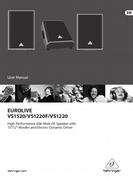
6 EUROLIVE VS1520/VS1220F/VS1220 User Manual
For the VS series, here are typical connection scenarios:
• Two 8 Ohm speakers in parallel = 4 Ohms
• Four 8 Ohm speakers in parallel = 2 Ohms
• Two 4 Ohm speakers in parallel = 2 Ohms
• Four 4 Ohm speakers in parallel = 1 Ohm
◊ Your amplifier may be damaged if the actual impedance drops below
its input impedance. Please make sure that the calculated total
impedance ZT is not smaller than the minimum impedance specified
for your amplifier.
3. Optimal Operation
We have developed the VS series for use in a wide range of possible applications.
Of course, the sound of your loudspeakers depends on the acoustic characteristics
of the room/space in which they are being used. The following chapters of
this manual will give you information about getting the most out of your
EUROLIVE loudspeakers.
3.1 Loudspeaker placement
Here are some tips to get optimal sound and performance from
your loudspeaker(s):
• Elevate the loudspeaker at or above head level. High frequencies are
the segment of the audio spectrum responsible for clarity and speech
intelligibility. They can get mued by the front row of the audience,
so we recommend positioning your loudspeakers so the high-frequency
drivers are slightly above the height of the audience. The more you can get
everyone in direct earshot, the better. Imagine the loudspeaker is a giant
ashlight, and you want to illuminate everyone in the room
• Avoid placing full-range loudspeakers in a corner or right next to a wall.
This enhances the low frequencies and can cause the sound to get muddy.
Subwoofers may be placed almost anywhere since low frequencies are not
highly directional
• Make sure that the loudspeakers are not in a place where they could
be knocked over by dancing audience members, overly eccentric stage
performers, sudden earthquakes, etc.
• Some rooms, such as gymnasiums and auditoriums, create a large amount
of natural reverb, making it dicult to maintain intelligible sound.
Laying carpet or rugs on the ground and curtains across windows or
brick walls will help dampen the reections and improve the overall sound
3.2 How to prevent feedback
Always place the “front of house” speakers ahead of the microphones
(from the audience’s perspective), and never behind. Use professional oor
monitors or an in-ear monitoring system to allow the stage performers to hear.
3.3 How to avoid feedback when working with
record players (DJ Applications)
In applications with record players, bass feedback can occur. Bass feedback
occurs when low frequencies get back to the pickup and are reproduced on the
loudspeakers. The most common causes for this are: speakers located too closely
to the record player, a room with a wooden oor, or presence of a podium or a
platform. In such cases, it is best to move the loudspeakers away from the record
player and remove them from the stage, so that they are located on rm ground.
Another option is to use raised stands, which prevent the loudspeakers from
having a direct contact with the ground.
3.4 Loudspeaker protection by using a
low-cut lter
Try to prevent damage to your loudspeakers caused by extreme oscillation
of the low-frequency driver due to subsonic noise and extremely deep
frequencies. Use an equalizer to cut o those frequencies that fall below
your loudspeakers’ frequency range, or use a low-cut/high-pass lter.
Most equalizers and sound-improvement systems oer a low-cut function,
like the BEHRINGER ULTRAGRAPH DIGITAL DEQ1024, for example. Using a low-cut
lter in your signal path is particularly recommended if you use record players
or CD players as your signal source. CD players often produce extremely deep
frequencies, which can lead to extreme excursions of the low-frequency driver.
4. Additional Considerations
4.1 Length and diameter of loudspeaker cables
Loudspeaker cables whose diameter is too small can considerably limit the
power amp performance. The longer the cable, the more pronounced the
problem. As a result, musicians often simply “turn up” the amp, which can lead
to loudspeaker damage. Therefore, don’t use cables longer than 15 m (45 ft.).
For most applications, this will not be necessary. Cable diameter should be at
least 14 - 12 gauge.
4.2 Power amp rating
Selecting the right amp can turn out to be rather dicult. Therefore, stick to
the following rule of thumb: the power rating of your amp should be roughly
twice the loudspeaker load capacity. A loudspeaker rated at 200 Watts
continuous performance can easily be powered by an amp rated at 400 Watts
output power. An optimal addition to your speaker system would be the
BEHRINGER EUROPOWER EP2000 power amp, for example.
4.3 Fuses
We do not recommend the use of fuses with loudspeaker applications. Damage to
loudspeakers can be the result of high peak signals and high output power.
However, fuses can only oer protection from one of these two factors, and never
from both. Additionally, fuse resistances are sometimes nonlinear, leading to
distortion and unpredictable overdriving.
4.4 Protecting your equipment
• Always try to nd the optimal signal level. Avoid overdriving your amp
• Keep in mind the physical limitations of your PA system
• Use a limiter to restrict the output signal level. Place the limiter
between the mixing console and the power amp. For this purpose,
our proven AUTOCOM PRO-XL MDX1600, COMPOSER PRO-XL MDX2600 and
MULTICOM PRO-XL MDX4600 compressors oer an outstanding solution.
All models can be used as a limiter: the audio signal doesn’t overdrive any
more, and unpleasant “peaks” are eectively avoided
◊ Our ULTRADRIVE PRO DCX2496 and SUPER-X CX3400/CX2310 crossovers
are particularly well-suited for protecting your equipment: for each
output, they have independent limiters.



























